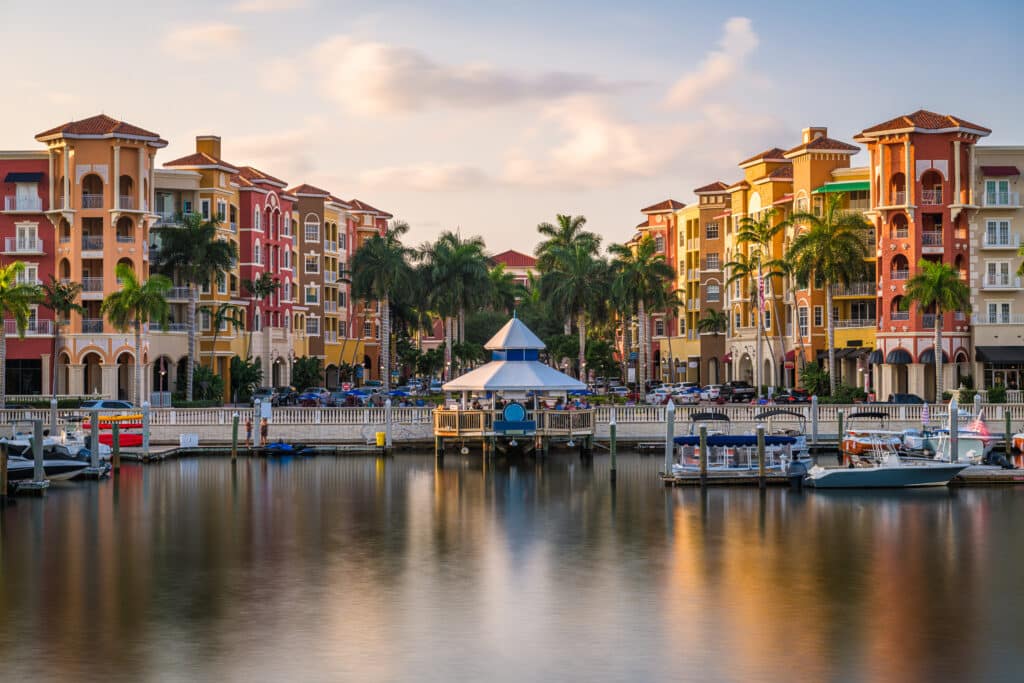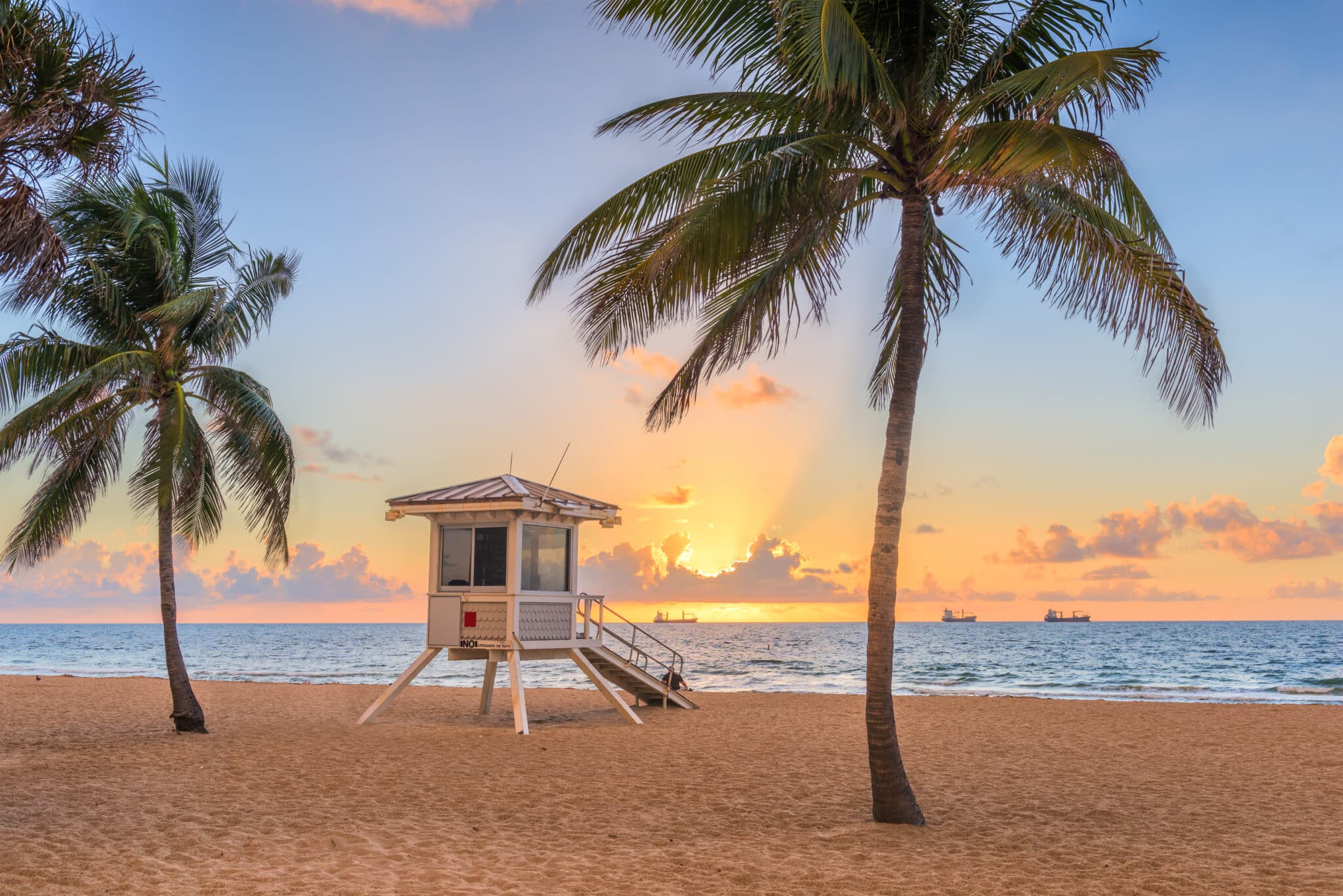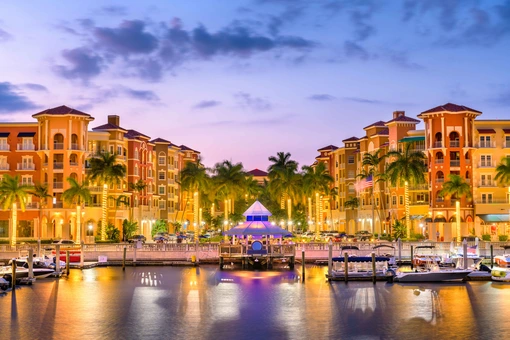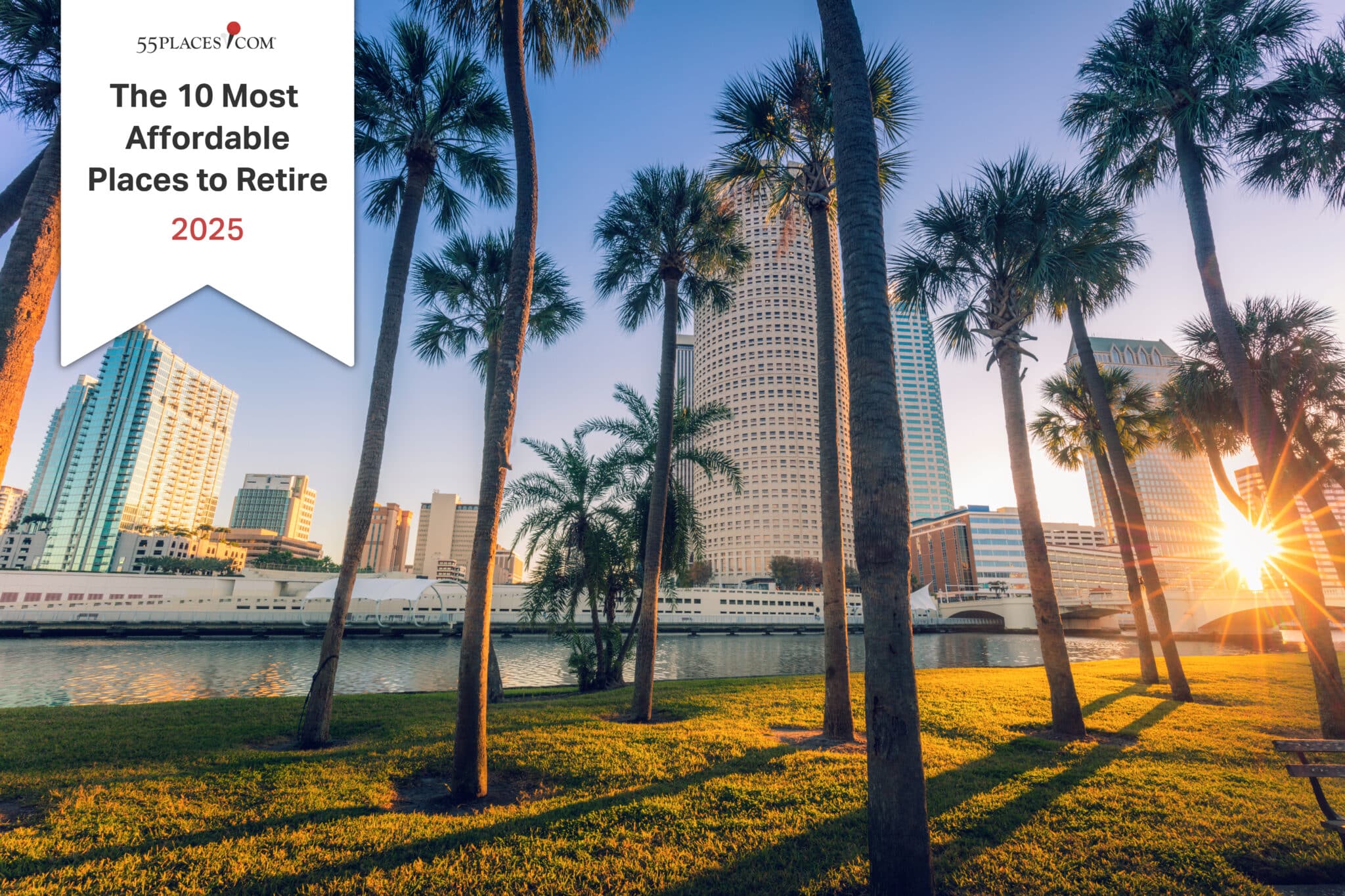For decades, Florida has been the most desirable retirement destination in the U.S. According to HousingWire, more than 18% of the Sunshine State’s total population is at retirement age. It’s a large state, but when people think about retiring to Florida, they’re mostly thinking about Southern Florida. That’s where we find the warmest weather, best-known beaches, and the Sunshine State’s tropical lifestyle. However, subtle differences can be found on Southern Florida’s East Coast (that’s the Atlantic side) and West Coast (that’s the Gulf side). Big waves crash against the East Coast, for example, while calmer waters are found on the West Coast.
Anyone moving to Florida has many resources available to them. To help active adults figure out which side of the state will best suit them, we’ve put together this guide to East Coast vs West Coast Florida pros and cons. Let’s take a look at what each part of the state means for affordability, amenities, rain, humidity, and real estate.
East Coast Florida: Vibrant & Fast-Paced

Southern Florida’s East Coast is a celebration of all things tropical and trendy. This part of Florida is moving quickly, whether we’re talking about new restaurants, creative art scenes, or luxury high-rise condos. People are retiring along Florida’s East Coast in cities such as:
Miami
The city itself has over half a million people but the entire Miami metropolitan area has over 6 million residents. This creates a lot of diversity, making Southern Florida’s most famous city an energetic, cosmopolitan mecca of art, culture, history, and seaside fun. People live in high-rise condos with astonishing views or cozy single-family homes in the green, lush suburbs of Miami-Dade County such as Coral Gables and Miami Lakes.
Fort Lauderdale
This is where residents choose to live when they want to be close to beaches, boating, and an active social scene that includes nightclubs, breweries, theater, and other forms of live entertainment. Fort Lauderdale has an international airport, and it’s a great home base for retirees and active adults who are interested in exploring the rest of Florida and other destinations.
Palm Beach
The lifestyle in and around Palm Beach is all about shopping, dining, and luxury living. If country club living is your vibe, this is the place to be. Golf is a very popular pastime, and there are around 145 courses to play. Palm Beach County is called Florida’s Golf Capital for a reason. There’s also a variety of real estate available, and homes can be purchased at a number of diverse price points.
Vero Beach
When it feels fun to live near a fast-paced city but not in that fast-paced city, a beach town like Vero Beach is the place to be. It’s a little quieter, it’s a lot less populated by tourists, and it provides a high quality of life with a lower price tag. People live here when they want easy access to the coast but fewer crowds and parties.
Looking at Florida’s East Coast, there’s a lot to love. The cities are alive with entertainment and top chefs and lofty wine menus, and there’s art and beauty and the ease of travel with multiple international airports and cruise ports.
The challenges are a higher cost of living than might be found elsewhere in Florida and a lot more crowds. Spring break season has local beaches welcoming thousands of college kids. Expect traffic, expect longer waiting times, and higher humidity. The climate is unbeatable in the winter, but those summers come with soaring temps and of course, the threat of hurricanes.
West Coast Florida: Relaxed & Scenic

Sliding across the state, we have the West Coast of Florida. There’s still the warm weather and access to sandy beaches and fantastic fishing. But, things move just a bit slower. Here’s where the largest population of active adults tend to live when it’s time to think about retiring to Florida’s Gulf coast:
Naples
Naples is known for its luxury communities, its high-end shopping, and its fantastic local art and theater scene. The white sand beaches are some of the loveliest in the state, and boating and fishing opportunities are everywhere. Golf is also a major activity in Naples. Explore more than 50 golf clubs and courses in and around Naples.
Sarasota
Another popular destination for active adults is Sarasota, where there are a variety of 55+ communities to choose from. There’s a lively downtown with shops and restaurants and nearby barrier islands that provide great beaches and additional opportunities for shopping and dining. There’s spring training baseball, major art museums like the Ringling, and local galleries and theater companies as well.
Fort Myers
Growing as a retirement destination, Fort Myers offers a bit more affordability and a lot less tourism than some of the other, more popular west coast cities. This is a popular spot for fishing and water sports like jet skiing, paddleboarding, and parasailing. There are a number of seafood restaurants and rum bars found at the beach, and boating is a very big deal. With a growing demand for housing, active adults can find condo communities as well as gated residential neighborhoods that offer amenities and activities.
Venice
Anyone moving to Florida in search of something that feels intimate and small-town-like will want to explore Venice. Known for its abundance of shark teeth on the shore and its iconic sunsets from the beautiful fishing pier, Venice offers all the seaside charm that you’d expect from a coastal village in the days of “Old Florida,” when tourism had not yet taken hold and major development projects hadn’t quite arrived. People in Venice love to stroll along the historic downtown area, and there are plenty of opportunities to live on or near the beach.
Living on the West Coast of South Florida means settling into a slower pace of life. There’s plenty to do, but no real hurry to do it. The sunsets along the Gulf coast are legendary, and whether you’re watching them from the privacy of your back patio or with dozens of locals along the water, they’re something to enjoy. This side of Florida is typically more affordable than the other side, too, thanks to a lower population and smaller cities.
The challenges of living here are the lack of major metropolitan areas. To get to a major international airport, one has to travel to Tampa or Orlando. There’s less public transportation on the West Coast, which means a car is almost always necessary. There is always the threat of tropical storms, too. The Gulf coast has been especially active in the last couple of years when it comes to receiving major hurricanes.
East Coast vs West Coast Florida Pros and Cons

Choosing which side to live on will depend on priorities.
Affordability
If it’s cost of living, most cities and towns on the Gulf coast will be more affordable when it comes to insurance. Housing prices can also be lower on the West Coast, and the cost of everyday essentials such as gas, food, and utilities trends higher in the East Coast cities.
Taxes
Taxes in Florida are something to celebrate, no matter where you choose to live. There’s no income tax here, and that includes social security benefits and retirement income. There’s also no inheritance or estate tax, leaving more of your money intact as a resident of Florida. Property taxes are going to be a bit higher on the East Coast, and that’s mostly due to the fact that home values are higher in these cities than they are in West Coast cities. While it seems unlikely, Channel 13 News recently reported many Florida legislators are talking about eliminating property taxes altogether. This would require a statewide constitutional amendment and voter approval.
Weather
The weather will be as warm in Sarasota as it is in Fort Lauderdale. However, there are slight differences to the average temperatures and the amount of wind and rain residents can expect. Florida’s West Coast generally enjoys slightly cooler and less-humid summers. Rain totals are lower and winters are a bit cooler thanks to the Gulf. On the East Coast, the temperatures average a bit higher and there’s more rain coming in off the Atlantic.
Hurricanes are a problem either way, and even if the storms aren’t named, the summer and early autumn months bring heavier tropical winds and rains.
Activities
The availability of activities, recreation, and entertainment doesn’t really change too much from the East Coast to the West Coast. Both have beaches and boating as well as fishing and hiking. There’s wildlife watching. If manatees are important, the West Coast is better. When you want crocodiles instead of alligators, stick to the East Coast and the Everglades. When it comes to music and entertainment, the East Coast has the edge with the Tortuga Music Festival in Fort Lauderdale every year and the Jazz in the Gardens event in Miami Gardens.
Health Care
Good doctors are absolutely necessary, and both sides of the state have them. On the East Coast, there’s Jupiter Medical Center in Palm Beach County, known for its cancer care and high levels of patient satisfaction. The Cleveland Clinic Cleveland Clinic is also in Weston and has exceptional emergency care and diagnostic facilities.
On the West Coast, it’s hard to beat Sarasota Memorial Hospital, which is consistently ranked among the state’s best healthcare facilities. Both Money Magazine and U.S. News and World Report have ranked it as one of the best hospitals nationwide, especially in areas such as rehabilitation.
Accessibility
While thinking about how to get around, active adults will also want to explore public transportation, including airports. Because some of the larger cities are on the East Coast, there’s more likely to be bus routes on that side of the state. On the West Coast, however, some cities like Venice and Sarasota provide bus routes, trolleys, and rideshares that cater specifically to people with transit needs. Older adults and people with disabilities can get customized support when it comes to transportation.
The West Coast has Sarasota Bradenton International Airport and the Southwest Florida International Airport in Fort Myers. Far more flights come and go from East Coast airports, however, including Miami International Airport and Fort Lauderdale-Hollywood International Airport.
As you explore the east coast vs. west coast Florida pros and cons, it’s important to think about lifestyle, budget, and personal preferences. On the East Coast, there’s a lot of action, higher costs, and easier access to transportation and facilities. On the West Coast, the pace is a bit slower and the price tag is a bit lower.
If you haven’t visited both coasts, we recommend that you explore what each side of the state feels like. That may be the best way to decide. It will also show you what it’s like to live in Florida.
When it comes to deciding where to retire in Southern Florida, the options are abundant. Explore 55+ communities on Florida’s East and West Coasts—contact 55places.com today!










